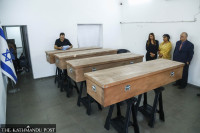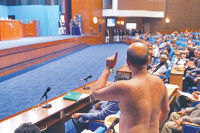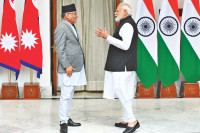Special Supplement
Double speak
Despite the legal arrangement to have at least 33 percent women representation in state mechanisms, the actual representation in the legislative body is dismal. There have been three national elections since the interim Constitution 2007 mandated, for the first time in the political history of Nepal, a fair representation of women in the government. Yet with each election, the number of women elected through the First- Past-the-Post (FPTP) system has been decreasing.
Kamal Dev Bhattarai
Despite the legal arrangement to have at least 33 percent women representation in state mechanisms, the actual representation in the legislative body is dismal. There have been three national elections since the interim Constitution 2007 mandated, for the first time in the political history of Nepal, a fair representation of women in the government. Yet with each election, the number of women elected through the First- Past-the-Post (FPTP) system has been decreasing.
In first Constituent Assembly (CA), 30 women were elected under FPTP, which was just 12.5 percent of total parliamentarians elected under FPTP. Twenty six of these women lawmakers were affiliated to the Maoist party of Nepal. At the time, the mandated 33 percent representation was reached in the first CA only through Proportionate Representation.
The number further came down to 4.17 percent in the second CA elections with a total 10 women candidates getting elected through the FPTP and the total representation of women fell to 30 percent, which openly violated the provision of the interim constitution.
The new constitution, promulgated in 2015, carries the provision of ensuring women representation in all legal bodies. While most major political parties have been pushing
for women’s inclusion in theory, its implementation tells another story altogether. A glaring instance of this could be
seen at recently-concluded election for the House of Representatives (HoR). Only six, out of the 165 lawmakers (or three percent) elected under First-Past-The-Post category, were women.
The issue is not just about the number of women candidates that won the elections, but also the number of women candidates that political parties fielded to face the general public. UML fielded five women (out of 103 candidates) , NC nine (out of 157 candidates) and Maoist Center four women candidates(out of 59 candidates ) in the HoR race. Women leaders, it seems, are not allowed to directly face the public to test their popularity.
While distributing tickets, many insiders say, party leaders believe that women are incapable of gathering the money, and muscle, which is unfortunately considered a necessary quality to win the elections.
Central Working Committee (CWC) member of Nepali Congress Dina Upadhaya said that the party leadership in general are not positive about providing tickets to women leaders. “Top leaders of the party think that women leaders cannot win elections,” she said, adding that there still is a patriarchal mindset within the party. The adamant stance of some of the party leaders, like Sher Bahadur Deuba, to preserve the leadership positions helmed by-in-large by men, shows that the structure will continue in the future as well.
It is not just the mainstream parties that had a gender imbalance when it came to candidates. Even the Bibesheel Sajha Party, touted as an alternative political force, failed to truly embrace a policy of inclusion when it comes to women candidacy. In the HoR elections, party contested in 63 constituencies but only five of the candidates were women.
The article 84(8) of the constitution clearly states: “Notwithstanding anything contained elsewhere in this Part, at least one third of the total number of members elected from each political party representing in the Federal Parliament must be women. If women are not so elected as to constitute one third of the elected members of any political party under sub-clause (a) of clause (1) and sub-clause (a) of clause (2) of Article 86, such political party must, in electing members under sub-clause (b) of clause (1), so elect that women members constitute at least one third of the total number of members elected to the Federal Parliament from the party.”
Despite the legal provision, it would appear that the problem continues because parties have not translated the constitutional provision into their party structures. While major political parties are pushing for women’s inclusion in theory, when it comes to the internal organisation set up—whether at policy, district, or grass-root levels—an acute imbalance still appears to reign supreme. For instance, take the example of the Nepali Congress, the Grand Old Party. Out of its 84-member Central Working Committee, only 15 members are women. This is more or less the same for most major other parties as well. Another glaring example is the current cabinet. Out of 34 ministers; only four are women ministers.
But despite the glaring imbalance in the FPTP race, there, however, has been an encouraging participation of women in the local bodies. Nearly, 40 percent of the elected representatives at local bodies are women. There is also a sizeable representation of Dalit women in these bodies. As per the constitutional provisions, deputies of all local levels are women––this has ensured women’s representation, but because of this provision parties have also found a reason to not field woman candidate for top positions of local-level governance.
Without other positives, the representation of women in the local bodies must be taken as some relief. In national politics, there is at least some consolation in the fact that the Proportionate Representation will ensure women‘s participation in the HoR. But if Nepal, however, stays satisfied with just one-third representation of women then the federal structure formed after decades of political instability might provide a stable government, but not an inclusive participation from all segments of the society.




 14.12°C Kathmandu
14.12°C Kathmandu










